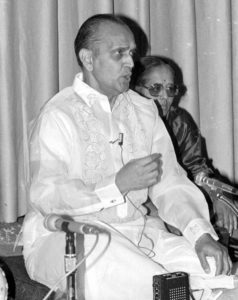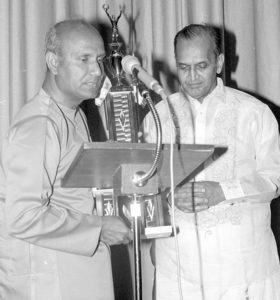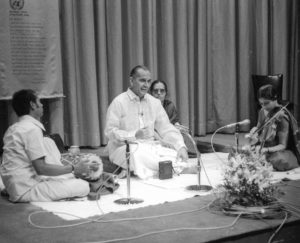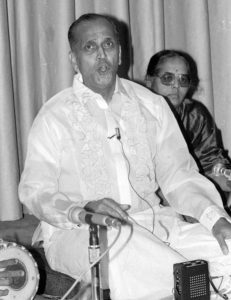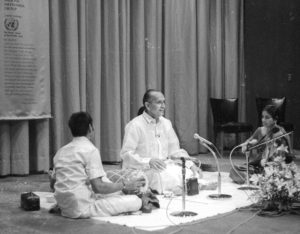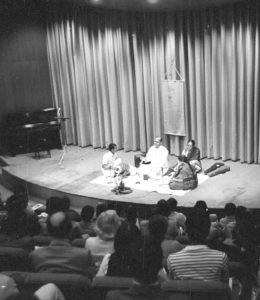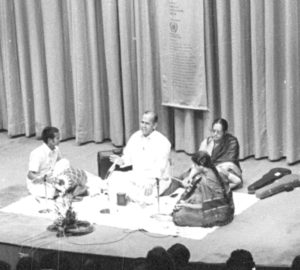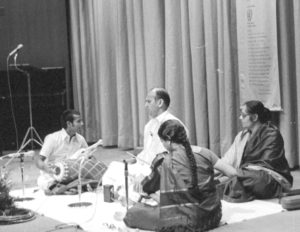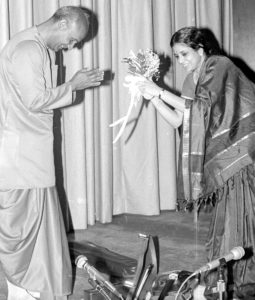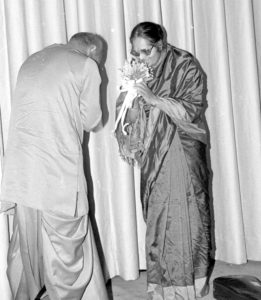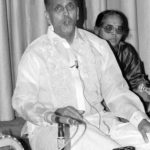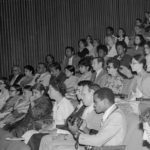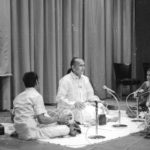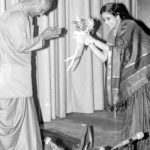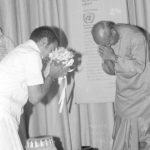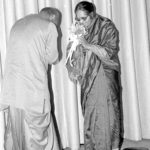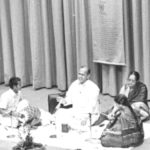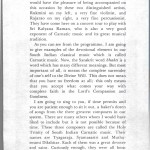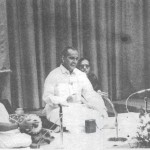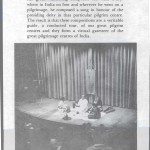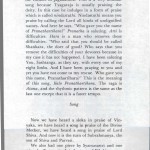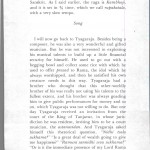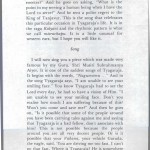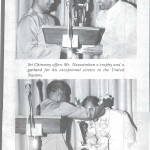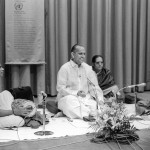Musical Lecture – Demonstration by C. V. Narasimhan: DETAILS ARTICLE 1978 May 30
Filed under Music and Songs | Tributes and Expressions of appreciationA LECTURE/ DEMONSTRATION BY C. V. NARASIMHAN
on the DEVOTIONAL ELEMENT OF SOUTH INDIAN CLASSICAL MUSIC
On the evening of 30 May 1978} Mr. C. V. Narasimhan, Under- Secretary-General for the United Nations Office of Inter-Agency Affairs and Co-ordination} offered a lecture/demonstration on the devotional element of South Indian Classical Music, sponsored by the Meditation Group. T
he concert of music and illumining instruction was followed by Indian snacks and lassi.
Following is a transcript of Mr. Narasimhan’s lecture, plus Sri Chinmoy’s expression of gratitude on behalf of the Meditation Group for the Under-Secretary- General’s exemplary dedicated service to the United Nations.
Reference Note: See also;
- A summary of event Musical Lecture- SUMMARY – Demonstration by C. V. Narasimhan which also appeared in 1978 Devoted Report to the Secretary General.
- An illumining article “Introduction to Carnatic Music” by C. V. Narasimhan, which appeared in Stagebill, the publication of Carnegie Hall, in October 1977, was reprinted for this 1978 event.
Mr. C. V. Narasimhan, Under-Secretary-General for Inter-Agency Affairs and Co-ordination:
Good evening, Sri Chinmoy, ladies and gentlemen, dear friends. When I planned the programme with Sri Chinmoy and Gail Gershon, I did not expect that I would have the pleasure of being accompanied on this occasion by these two distinguished artists, Rukmini on my left, a very fine violinist, and Rajarao on my right, a very fine percussionist. They have come here on a concert tour to play with Sri Kalyana Raman, who is also a very good exponent of Carnatic music and its great musical tradition.
As you can see from the programme, I am going to give examples of the devotional element in our South Indian classical music which is called Carnatic music. Now, the Sanskrit word bhakti is a word which has many different meanings. But most important of all, it means the complete surrender of one’s self to the Divine Will. This does not mean that you have no freedom at all ; this only means that you accept what comes your way with complete faith in the Lord’s Compassion . and Goodness.
I am going to sing to you, if time permits and you are patient enough to sit it out, a baker’s dozen of songs from the three greatest composers in our system. There are many others whom I would have liked to include but it is not possible because of time. These three composers are called the Holy Trinity of South Indian Carnatic music. Their names are Tyagaraja, Syamasastri and Muthuswami Dikshitar. Each of them was a great devotee and saint. Curiously enough, they were all born within a few years of each other in the same small town in South India called Tiruvarur in the mid- 18th century.
Syamasastri stayed in Tiruvarur all his life. Tyagaraja moved to a town called Tiruvaiyyar, the town of the five rivers, where to this day there is a shrine in his memory. Muthuswami Dikshitar was our great wandering composer. He went everywhere in India on foot and wherever he went on a pilgrimage, he composed a song in honour of the presiding deity in that particular pilgrim centre. The result is that these compositions are a veritable guide, a conducted tour, of our great pilgrim centres and they form a virtual gazetteer of the great pilgrimage centres of India.
These three composers were all completely selfless and their music means so much to me because it is not mere esthetic pleasure that you are seeking when you listen to this music. It is the possibility of actually soaring on wings of song into the ethereal heights where is is possible for you to establish communion with the Lord Himself. Many of these songs have a supreme moment and as we go along I will explain to you what I mean by the supreme moment. But they cannot easily be explained. Tyagaraja says in one of his compositions, “I cannot explain all this to you ; it is something that you have to experience by yourself.”
I can only report that the object of our music, as conceived by these great composers, is not to entertain; it is not to please the ear. It is to reach out and touch your heart and to make it possible for you to tune yourself in to the same wavelength as the Infinite so that you can establish in that supreme moment a communion with the Lord Himself.
I am very grateful again to my two accompanying artists. I only feel that this recital will not do justice to their great talents because the programme is conceived in a different way from the usual concert of Carnatic music.
I will start with a brief invocation to Lord Vighneswara, also called Ganapati and Vinayaka , the Remover of Obstacles. Then I shall sing a song in praise of the Divine Mother by Syamasastri – it is in the raga Ananda BhairaV’l~ and the tala is 8 beats : 4 plus 2 plus 2 beats. Song
I shall now sing for you a piece by Tyagaraja. As I told you a little while ago, Tyagaraja settled down in Tiruvaiyyar, the city of the five rivers. And he has composed a song in praise of Lord Shiva, the consort of Jagadamba. This is a very unusual song because Tyagaraja is usually praising the deity. In this case he indulges in a form of praise which is called nindastuthi. Nindastuthi means you praise by calling the Lord all kinds of undignified names. And here he says, “Who gave you the name of Pranathartihara?” Pranatha is saluting. Arti is difficulties. Hara is a man who removes these difficulties. “Who said that you should be called Shankara, the doer of good? Who says that you remove the difficulties of your devotees because in my case it has not happened. I have been saluting You, Sashtanga, as they say, with everyone of my eight limbs. And I have been praying to you and yet you have not come to my rescue. Who gave you this name, Pranathartihara?” This is the meaning of this song, Ilaio Pranathartihara. The raga is Atana, and the rhythmic pattern is the same as the last one except that it is a faster tempo.
Song
Now we have heard a sloka in praise of Vinyaka, we have heard a song in praise of the Divine Mother, we have hear d a song in praise of Lord Shiva . And now it is the turn of Subrahmanya, the son of Shiva and Parvati.
We also had one piece by Syamasastri and one piece by Tyagaraja. It is the turn of Dikshitar now. And I shall sing for you one of the greatest compositions, one of the treasures of our classical 22 system in the raga Kambhoji beginning with the words, “Shri Subrahmanyaya namaste.” I am encouraged to sing this song because I have the support of Rukmini and Rajarao. This is indeed a very fine piece. All Dikshitar compositions are in Sanskrit. As I said earlier, the raga is Kambhoji, and it is set in % time, which we call rupakatala, with a very slow tempo.
Song
I will now go back to Tyagaraja. Besides being a composer, he was also a very wonderful and gifted musician. But he was not interested in exploiting his musical talents to build up a little financial security for himself. He used to go out with a begging bowl and collect some rice with which he used to offer prasad to Rama, the idol which he always worshipped, and then he satisfied his own creature needs in this way. Tyagaraja had a brother who thought that this other-worldly brother of his was really not using his talents to the fullest extent, and his brother was always goading him to give public performances for money and so on, which Tyagaraja was not willing to do. But one day Tyagaraja received an invitation from the court of the King of Tanjavur, in whose jurisdiction he was resident, inviting him to be a court musician, the astanavidan. And Tyagaraja asked himself this rhetorical question, “Nidhi tsala sukhama.'” “Is a great deal of wealth going to give me happiness?” “Ramuni sannidhi seva sukhama.?” “Or is it the immediate presence of my Lord Rama and my opportunity to serve Him, is that going to . give me greater satisfaction? Oh my mind, please tell me truthfully.” And then he goes on asking, “Which is sweeter, yoghurt, butter, milk? Is this sweeter, or the nectar, the ambrosia that flows from the bhajana of Lord Rama? Which is sweeter?” And he goes on asking, “What is the point in my serving a human being when I have the Lord to serve?” And he sent a polite regret to the King of Tanjavur. This is the song that celebrates this particular occasion in Tyagaraja’s life. It is in the raga Kalyani and the rhythmic pattern is what we call misrachapu. It is a little unusual for western ears, but I hope you will like it.
Song
I will now sing you a piece which was made very famous by my Guru, Shri Musiri Subrahmanya Aiyer. It is one of the saddest songs of Tyagaraja. It begins with the words, “Nagumomu .. . ” And in the song Tyagaraja says, “I am unable to see your smiling face.” You know Tyagara ja had to see the Lord every day, he had to have a vision of Him. “I am unable to see your smiling face. Don’t you realise how much I am suffering because of this? Won’t you come and save me?” And then he goes on, “Is it possible that some of the people around you have been carrying tales against me and saying that Tyagaraja is a bad fellow, don’t associate with him? This is not possible because the people around you are all very decent people. Or is it possible that your Vahana , your vehicle Garuda, the eagle, said, ‘You are driving me too fast. I can’t go that fast. Where is Tyagaraja? He is somewhere on earth. We are somewhere in Heaven. It is so far to go. You know the price of gasoline these days.’ Is that what he is saying to You?” And then the supreme moment comes and he says, ‘Jagamele, Paramatma … ” “If You, the Paramatma, who are the Supreme Court of Appeal, if You deny me justice, to which higher court can I appeal? Please come and save me!” This is the meaning of this song. It is in the raga Abher( and the tala is the same 4/4 time: 4 pI us 2 plus 2, also in a slower tempo.
Song
I shall sing another piece by Tyagaraja. It is a very short piece in the raga called Bhavdharz”. And in the song Tyagaraja says, “In this whole world, for you, Rama, to save this little Tyagaraja, this little me, is this so difficult for You? At the time of the churning of the ocean of milk, in order to get the nectar, the story is that the devas and asuras used Vasuki, the giant serpent, as the rope. But when you put the churn inside the ocean, of course it sinks, so they needed a platform. And the Lord appeared in the form of Kurmavatara, the second of the ten incarnations of Vishnu, and provided a platform for the mountain Meru to be used as the churn. This is the tradition at any rate. Tyagaraja says, “In order to provide a platform for these devas, for these celestials, you made yourself into Kurmavatara. Because it was raining one day in Mathura, as Krishna you lifted the Govardhana mountain with your little finger to provide an umbrella for these milkmaids.” Tyagaraja asks “What would have happened if they had got wet? You raised the mountain in order to be able to save them from getting wet. For a person such as you, is it so difficult to save this little Tyagaraja?” This is the meaning of the song.
And you will find that when he says, “Did you not raise the mountain in order to save the milkmaidens from getting wet?” that the music also soars with the song.
Song
I will sing another piece by Tyagaraja. This is a very well-known song, although it is sung in different ways by different people. But I learned to sing this in the raga called Devamrutavarshini. And the words of this song are, “How did the elite amongst men worship You? What did they determine You to be? Did they decide that You are Shiva, or Madhava, which is Vishnu, or Brahma, the Lord of Saraswati, or did they decide that You are Paramabrahman, the Supreme Being?” And then he goes on to say, “In the Shiva mantram, Aum Namahsivaya, the key letter is Ma, the second letter. In the Vishnu mantram, Aum namo Narayanaya, the key letter is Ra. Now if you take the Ra from A um namo Narayanaya and the Ma from Aum Namahsivaya, you get Rama. And that is how the name Rama came into being, and that is how the elite amongst men worshipped You.” This is the song I am going to sing for you.
Song
Time is passing but I cannot resist singing one more song by Tyagaraja. It is in the raga Kapi and it is also an unusual rhythmic pattern which we call kandachapu. And in this song again Tyagaraja blames himself for all the problems he is facing in this world, his inability to see Rama every day and all the suffering he is undergoing at that time. He says, “It is all my fault. It is not any fault of Yours. It is all my fault that I am suffering like this.”
Song
I shall end with two pieces, one by Syamasastri and the other by Dikshitar. And you will notice that the pitch has changed. This madhyama sruthi is used when the raga in which we sing a song is called Nishadantya raga – that means it does not run the full gamut of two octaves but stops at one octave. In order not to sing too much in the lower register, you raise the pitch. You go to the fourth or madhyama.
Song
I will end with a piece by Dikshitar, beginning with the words, Srivenugopala. Dikshitar also describes the Lord as Sri Rukminilola and we have Rukmini playing for us, and her lola (husband) is over there in case you haven’t met him before.
Song
Thank you very much.
Sri Chinmoy:
We are extremely grateful to you, most revered brother Narasimhan.
We are extremely grateful to you for your most soulful, most illumining and most fulfilling songs. Your matchless selfless service to the soul and the body of the United Nations can only be felt and never be described, for it will always beggar description.
Only the sincere seekers who are serving the United Nations know how selflessly you have been serving the United Nations. The length and the breadth of the world will always remain indebted to you, for you have and you are a genuine heart. Mother India and the entire world will always be proud of you. And we, the members of the United Nations shall always remain grateful to you with our heart of simplicity, sincerity and devotedness.
Sri Chinmoy offers Mr. Narasimhan a trophy and a garland for his exceptional service to the United Nations.
Sri Chinmoy presents Mrs. Narasimhan with a bouquet of flowers after the concert.
Gallery 1:
- (c) Copyrights Sri Chinmoy Centre
- (c) Copyrights Sri Chinmoy Centre
- (c) Copyrights Sri Chinmoy Centre
- (c) Copyrights Sri Chinmoy Centre
- (c) Copyrights Sri Chinmoy Centre
- (c) Copyrights Sri Chinmoy Centre
- (c) Copyrights Sri Chinmoy Centre
- (c) Copyrights Sri Chinmoy Centre
- (c) Copyrights Sri Chinmoy Centre
- (c) Copyrights Sri Chinmoy Centre
- (c) Copyrights Sri Chinmoy Centre
- (c) Copyrights Sri Chinmoy Centre
- (c) Copyrights Sri Chinmoy Centre
- (c) Copyrights Sri Chinmoy Centre
- (c) Copyrights Sri Chinmoy Centre
- (c) Copyrights Sri Chinmoy Centre
- (c) Copyrights Sri Chinmoy Centre
- (c) Copyrights Sri Chinmoy Centre
- (c) Copyrights Sri Chinmoy Centre
- (c) Copyrights Sri Chinmoy Centre
- (c) Copyrights Sri Chinmoy Centre
- 1978-05-30-18-sri-chinmoy-presents-reophy-to-Mr-Narasimha
- (c) Copyrights Sri Chinmoy Centre
- (c) Copyrights Sri Chinmoy Centre
Gallery 2:
Click on image below for larger or different resolution photo – image.
- (c) Copyrights Sri Chinmoy Centre
- (c) Copyrights Sri Chinmoy Centre
- (c) Copyrights Sri Chinmoy Centre
- (c) Copyrights Sri Chinmoy Centre
- (c) Copyrights Sri Chinmoy Centre
- (c) Copyrights Sri Chinmoy Centre
- (c) Copyrights Sri Chinmoy Centre
- (c) Copyrights Sri Chinmoy Centre
- (c) Copyrights Sri Chinmoy Centre
- (c) Copyrights Sri Chinmoy Centre
- (c) Copyrights Sri Chinmoy Centre
- (c) Copyrights Sri Chinmoy Centre
- (c) Copyrights Sri Chinmoy Centre
- (c) Copyrights Sri Chinmoy Centre
- (c) Copyrights Sri Chinmoy Centre
- (c) Copyrights Sri Chinmoy Centre
- (c) Copyrights Sri Chinmoy Centre
- (c) Copyrights Sri Chinmoy Centre
- (c) Copyrights Sri Chinmoy Centre
- 1978-05-30-18-sri-chinmoy-presents-reophy-to-Mr-Narasimha
- (c) Copyrights Sri Chinmoy Centre
- (c) Copyrights Sri Chinmoy Centre
- (c) Copyrights Sri Chinmoy Centre
- (c) Copyrights Sri Chinmoy Centre
- (c) Copyrights Sri Chinmoy Centre
- 1978-05-may-30-Narasimhan-india-concert-scpmaun-1978-06-27-onstage-narasimhan-crp




